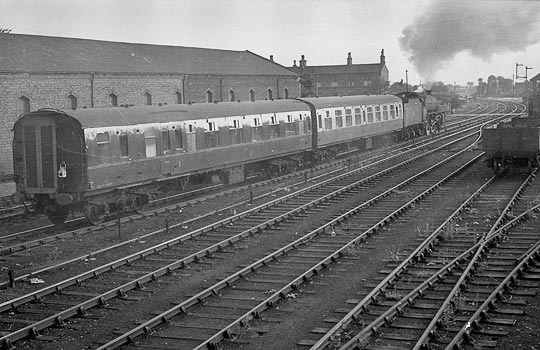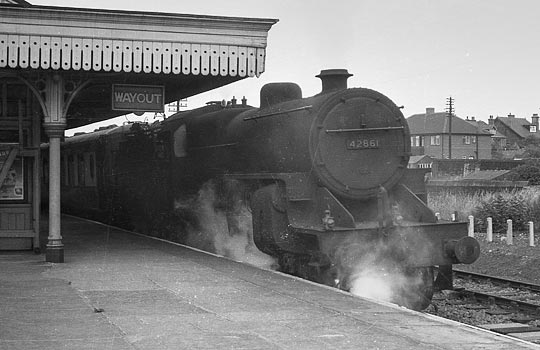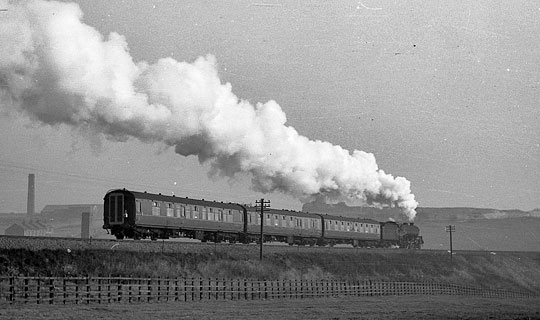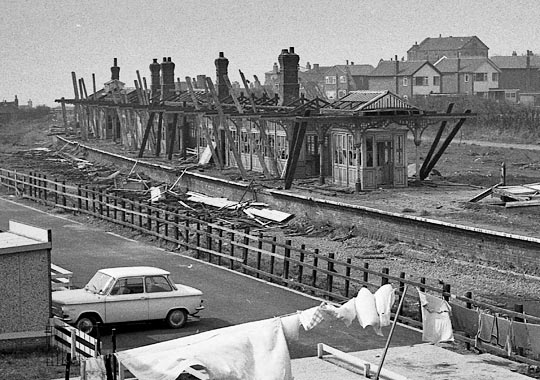Roger Hepworth peers out of his window as morning commuters board... The London train
Roger Hepworth peers out of his window as morning commuters board… The London train
Living now in the same house I grew up in, I am often struck by how hard it is to overlook the redeveloped area over which I once had, from the upstairs windows, a grandstand view of our busy local passenger station, goods yard and level crossing. As much as the sights it is the sounds I miss – the assorted noises that once punctuated the passing of a summer’s day. There would be the puffing of steam engines in various moods, the clashing of buffers, the shouting of porters, guards and shunters, and the squeals from the wheels of shunted wagons as they were dragged protesting over the goods yard points and indeed as trains ran through the station on the sharply curved and check-railed Down Main line. These were a part of everyday life, hardly noticed and then only subconsciously at the time.

Photo: Roger Hepworth
The Bradford to Wakefield branch via Ossett was one of the first in the country to receive the ‘new diesels’ in the mid 1950s. Discounting the early morning comings and goings of these hourly DMUs, the first main event of the day and the indication of breakfast time was the passage of the ‘five to eight London train’, the fast-approaching hurried beat of the engine breasting the stiff uphill gradient from Dewsbury; the closing of the regulator, perhaps some blowing-off of steam and the squeal of brakes as the train ground to a halt at the platform. The slamming of carriage doors, the distant echoing shout of ‘Right-away’ from the guard, an answering ‘pop’ on the clear whistle of the Ardsley ‘B1’, often No.61031 Reedbuck, the ‘cluck’ from the snifting valve as the driver opened the regulator and the urgent crisp exhaust beat sounding out. A few clear puffs, then several muffled ones as the engine passed under the road overbridge at the east end of the station, then clear again echoing off the nearby goods shed as the engine rapidly accelerated down the gradient towards Wakefield.
If I cared to look out of my house window I could see the sun gleaming off the polished black engine and the two red and cream coaches – a side corridor third and a brake composite proudly roofboarded ‘King’s Cross – Bradford’. Their cargo of businessmen and other people would be opening their morning papers, having the first sandwiches out of their packed lunches or simply relaxing and looking out of the window. The final view from my house would be the black canvas and grey painted wood of the corridor connection end-shield and white tail lamp fast disappearing round the left-hand curve under a trail of white exhaust steam. The engine whistle would blow for the level crossing and shortly there would be the clattering of the gates closing as the signalman in Ossett East box quickly wound around the ‘ship’s wheel’ that controlled them.

Photo: Roger Hepworth
On arriving at Wakefield in about ten minutes’ time the coaches would be drawn back off the train engine by the yard pilot, often an N1 0-6-2 tank, into the Up sidings. There would then be an expectant wait for the main portion to arrive from Leeds. The buck-eye coupler would be lifted into position at the front end, the side buffers retracted and the corridor end shield removed and placed in the rack, the marks of which are still to be seen on the back wall of the Up platform today. Then heads leaning out of the carriage windows would spot the ‘blinkered’ front end of a Copley Hill A1 rapidly approaching out of the industrial haze of the sunny 1950s morning. The huge bulk of ‘H A Ivatt’ or ‘Madge Wildfire’ (that perfect Waverley novels name!) would glide past, her driver gazing intently ahead, ready to stop at exactly the right point along the platform. The engine was followed by ten smart clean coaches which would thump past over the point work. Some were older wooden-bodied coaches, with mirrors and pictures in each compartment; others were newly-built with open-plan seating at tables and little white name-plates inside informing the passengers of the origins of the internal wood veneers. Who but an old-time rail traveller has heard of ‘weathered sycamore’? In the restaurant car white-coated waiters would be putting the finishing touches to the breakfast tables. Occasionally an open wooden framed droplight in the kitchen car would reveal the face of the busy chef hard at work preparing breakfast.

Photo: Roger Hepworth
As soon as the train had come to a stand, off came the tail lamp and corridor end shield. The vacuum brake hose was removed from its seating and the steam heat hose freed from its restraining chain. Buffers were retracted and the cast steel spacing blocks hung on the little hooks on the coach end. The RCH lighting cable plugs were lifted from their wooden box housings above the buffers, all this being performed as a matter of routine by one of the two regular shunters under the watchful eye of the duty platform inspector with his smart uniform and peaked cap. Having raised the heavy buck-eye coupler and inserted the pin to keep it in position the shunter would scramble up onto the platform and give a hand signal to the yard pilot driver to push the Bradford coaches forward. The initial vigorous rotary movement of his whole forearm gave way as the distance to be traversed decreased to an up-and-down movement of the hand until with a gentle but firm ‘clunk’ the couplers meshed. Corridor connection doors were unlocked with a long slim key, the vacuum and steam heating hoses and lighting cables were coupled and suddenly the train was ready for departure. The Leeds guard came down from the front van to occupy the rear brake in the Bradford portion.
As the pilot engine was uncoupled from the rear and a brake test carried out, the last few doors were slammed shut and the platform loudspeakers finally announced the calling points of “Doncaster, Retford, Newark, Grantham, Peterborough North and London King’s Cross”. The inspector’s raised hand was answered by a wave of the green flag from the guard. The inspector swung on his heel and raised his hand towards the front of the train. Far away along the platform with its dingy canopy and groups of people seeing off friends and relations the Pacific’s driver blew his engine’s whistle and, as often as not, set back so as to compress the train’s buffer springs. As the train then sprang forward the three-cylinder engine took up its characteristically gentle but firm chaff-CHAFF-chaff-chaff exhaust and the train wound its rear end out of the yard and along the platform. As the searchlight signal switched its aspect from green back to red the carriages snaked out of the platform loop onto the main line, then out onto the ‘Ninety-nine Arch’ viaduct.

Photo: Roger Hepworth
In went the guard’s head and up snapped the window as the engine at the front coasted along the short downhill stretch over Ings Road Junction before being opened up with a sudden pluming of steam from the double chimney. For those on the train there would be the anticipation of a pleasant three-hour journey, maybe in a compartment with watercolour prints of eastern counties villages, or the ubiquitous ‘Welwyn Garden City, Herts’. There would be a choice of two breakfast sittings – before and after Peterborough. Each was heralded by the typically north London accented gravel voice of an attendant who would slide open the compartment door and announce “First (or Second) call for breakfast”. There was also the opportunity to obtain a hot drink from the white-coated corridor attendant, who would deftly wield his twin silver pots of coffee and milk in exchange for a small sum of money.
For those left on the platform there would be a large variety of train movements to observe and only a short wait until the whole train-combining procedure was repeated with the next London service or, on a summer Saturday, a service to any one of a variety of seaside towns. This is to say nothing of workings in the Down direction being split, all by the same team of staff. The engine of a Leeds portion always worked through to the destination. Engines off Bradford portions were uncoupled on arrival at Wakefield and ran forward before reversing back over the pointwork to the north end of the station. Here they would wait on an especially long head shunt at the Leeds end of the Down Platform Loop – tender engines sometimes having turned on the Wrenthorpe triangle. On summer Saturdays, as well the London services, trains to and from Cleethorpes, Scarborough, Skegness and even Yarmouth would combine southbound and split northbound. To the discerning small boy these ‘Bradford portions’ provided a luxurious alternative Saturday service to the everyday DMUs along the Ossett branch. The aforementioned head shunt at Westgate could be holding up to five engines, all awaiting their turn to back down onto the succession of Bradford-bound portions. These had a choice of getting to Bradford either via Morley or via Ossett as far as Adwalton Junction where the routes combined and where a solitary wooden lighting pole today remains to show the initiated where the busy level crossing once was.

Photo: Roger Hepworth
And what of Ossett now on a summer Saturday afternoon? The track through the Dewsbury-bound platform was on a sharp curve and steep uphill gradient before it dropped steeply towards Earlsheaton and Dewsbury. Where the station area once rang half-hourly to the strident exhausts – often in double-headed combinations – of B1s, K1s, Black 5s,Standard 5s, 4Fs, J39s, J6s, L1s, Crabs, Ivatt 2-6-0s, Fowler and Fairburn 2-6-4 tanks, and on one memorable occasion, Jubilee ‘Swiftsure’ straining to restart their heavy returning holiday trains and the shouts of excited children on the platform just home from their holidays there is now only the occasional dead buzz of a lawnmower and the passing of a 126 bus to pass the time. Progress? Hmm…





